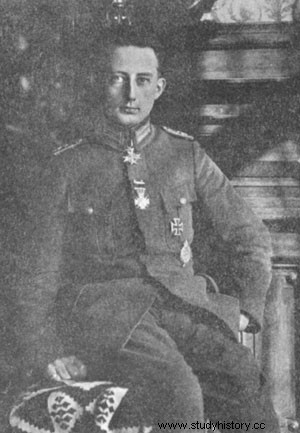Werner Voss (April 13, 1897 – September 23, 1917) was a German World War I flying ace who died in action.
48 wins

Born April 13, 1897 in Krefeld, Rhineland-Westphalia, in Thirty kilometers from the Netherlands, Werner Voss seemed destined to follow the path of his father, a dyer, when the First World War broke out. Having previously volunteered to join the Krefeld militia, he was assigned to the 11th company of the Westphalian hussars on November 16, 1914 and was deployed with it on the eastern front. In less than seven months, he rose from the rank of simple hussar to that of non-commissioned officer, earning the second class Iron Cross in the process. But, tired of the mud and the suffering inherent in the cavalry on the front, he asked for and was granted a transfer to an air force school in August 1915. He took flying lessons in Krefeld and Cologne then, after becoming an instructor pilot - the youngest - until February 1916 and observer thereafter, he obtained the precious pilot's badge on May 28 of the same year.
The brand new lieutenant (September 9) quickly aspires to fly something other than an observation two-seater and makes a request to do so. On November 21, 1916 he was temporarily assigned to Jasta 2, the squadron of the late Oswald Boelcke, based in Lagnicourt between Cambrai and Arras. Very quickly Voss impressed his comrades, among whom were the aces Manfred von Richthofen and Erwin Böhme. On November 27, he obtained his first confirmed victory by shooting down a Nieuport 17 and in order to demonstrate that luck owed nothing to that, he took to the air again that same day and shot down an FE2b. His assignment soon became final.
Voss earned 28 victories with the Jasta 2 as well as the Iron Cross First Class, Knight's Cross with Swords of the House Order of Hohenzollern, and the coveted For Merit Medal. Having received the command of Jasta 5 based in Cappy-sur-Somme, he adds 6 new victories to his record. Sure of himself, the young pilot has no qualms, going so far as to unload his machine guns on a downed plane heading for the ground to ensure that the opposing pilot was not feigning. However, he multiplies the acts of recklessness and he is briefly entrusted with the command of Jasta 29 and then that of Jasta 14.
Integration to Manfred von Richthofen's "Cirque Volant"
Manfred von Richthofen, the famous red baron to whom he has been bound by a frank and solid friendship since their meeting at Jasta 2, does everything possible to integrate Voss into his "Cirque Volant", the Jagdgeschwader 1, a formation of elite including Jastas 4, 6, 10 and 11, and it is only natural that Werner Voss ends up joining Jasta 10, on July 30, 1917, which he actually commands. He recorded 14 other victories on his list, including 10 on the famous Fokker Triplane Dr1, of which he officially received the 3rd prototype on August 28, 1917 and to which he gave his first letters of nobility. Voss had in fact been the first to try the new aircraft and had even piloted it 2 days earlier during a demonstration given in the presence of Generalissimo Ludendorff who was very impressed.
Last mission
On September 23, 1917, shortly after 6 p.m., Werner Voss decided to take off for one last mission, unescorted, determined to track down those lost in the afternoon battles. He is apparently keen to obtain his 50th victory before taking the rest that the German high command had ordered him to observe and for which his father and his brothers had come to seek him. Having seen after a few minutes a solitary SE5 returning to its base, the German ace chased it. Obsessed with his target, he did not see six other SE5s belonging to 56 Squadron swoop down on him.
These fearsome devices were not in the hands of novices since the British aces James McCudden, Arthur Rhys Davids, Reg Hoidge and Gerald Bowman were among the pilots. At the first shots, Voss faced his opponents. Although numerically unbalanced, the ten-minute fight was never broken by Voss who, according to one of the British pilots present, could have done so whenever he wanted. Major McCudden, commander of 56 Squadron, later said that he "seemed to be always shooting at us all at once" and that "his maneuvers were so fast we couldn't get our sights on him." ". However, despite the intervention of the German ace Carl Menckhoff at the controls of his Albatros which quickly turns course, Voss is fatally hit by a burst of fire from Rhys Davids.
His aircraft crashed after a long dive about 800m inside the English lines, north of St Julien. The English aircraft returned to base due to nightfall and it was not until the next day that they learned the identity of their downed opponent. Quickly buried by British troops, the location of his grave was forever changed by heavy fighting later. Of the 7 Allied aircraft that took part in the fight, all returned hit by German machine guns, 4 of which were seriously damaged.
Many German and Allied pilots considered Voss to be the best fighter pilot of the Great War. Rhys Davids later regretted killing him by shooting him down, and McCudden wrote this about the "holy fellow" he and his men had fought:"As long as I live I shall never forget the admiration that I bring to this pilot who fought alone 7 of us during 10 minutes and touched all our machines. His flight was wonderful, his courage magnificent, and he is, in my opinion, the bravest German pilot I have had the privilege of seeing fight.
